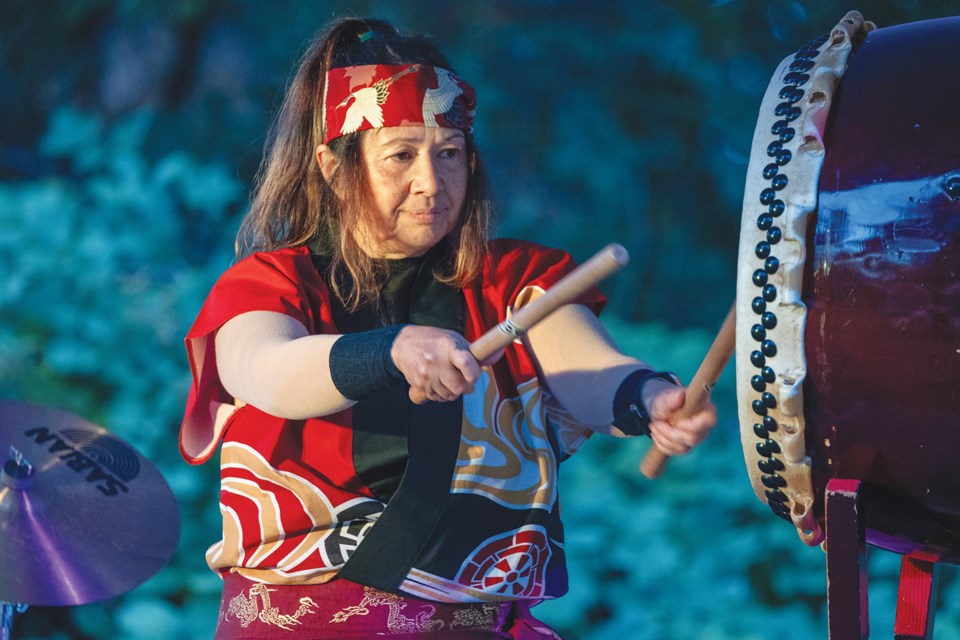A dazzlingly original harvest ritual provided an entrée to autumn on Sept. 21, as the Sechelt Arts Festival took another step in its ongoing transformation.
Over a hundred community members gathered at the Davis Bay pier when the setting sun gleamed golden for the first-of-its-kind procession. Master puppeteer Gerardo Avila initiated the rite, his face eclipsed by a solar mask encircled by pointed rays.
Two members of Bushido, a Japanese world music duo based in Vancouver, led the crowd southward to Mission Point Park: Alcvin Ryūzen Ramos played the Shakuhachi bamboo flute and Nori Akagi kept time on a taiko drum.
Flag-bearers hoisted banners designed by Hazel Bell-Koski. Each ensign bore images depicting traditional West Coast food-gathering practices.
Marchers passed an oversize eagle puppet, held aloft by three artists perched at the verge of the rising tide. The bird took its place among the crowd.
The three-hour arts festival was a project of the Sunshine Coast Arts Council. The council, in its first year of organizing the 21-year-old Sechelt Arts Festival, collaborated with the Rogue Arts Festival to recruit musical performers.
“It was brilliant and a beautiful way to start,” said Sadira Rodrigues, curator-director of the arts council.
Standing on the sea-swept sand of Mission Point, shíshálh Nation cultural ambassador Andy Johnson and dancer Cora Lee Joe-Louise welcomed participants to the territory.
The festival (titled Stories of the Estuary) was part of a months-long series of local events celebrating the Salish Sea’s waterways, including stories of travel and exchange.
“Plastics! So toxic!” chanted the Bushido musicians, joined by members of the Onibana Taiko ensemble, Noriko Kobayashi and Kage. “Let’s all reduce and repurpose until no more! The sun, the moon, the air and the water — the Raven knows.”
Avila narrated an original dance performance by Maggie Guzzi (adorned as a raven) and Connor Dixon, portraying the embodiment of manufactured excess. “We’re crossing the celestial equator,” Avila explained. “The Salish Sea spoke, [saying] turn the tide on plastics. And the Raven listened.”
Item by item, Guzzi’s raven stripped plastic detritus from Dixon’s torso, revealing translucent seafoam-coloured raiment underneath. Costumes were designed by Gibsons-based textile artist Conchita Harding.
Musical performances followed, featuring thrumming electronica by the Walrus duo and upbeat reggae numbers rendered by afrobeat ensemble Mivule.
shíshálh artist Jessica Silvey led instruction in creating cockle shell candles. Each year, she said, she gathers cockles from the shoreline. After her husband devours the mollusc meat, she uses soy wax to fix a wick in each concave surface.
“People can’t believe we’re reusing a cockle,” said Silvey. “They say, ‘We just walk over these shells all the time.’ Everyone’s sort of amazed that something as simple as a cockleshell brings you joy.”
Children coloured original fabric designs by Ali and Bella Casey that will be sewn into a blanket commemorating the event.
Gibsons-based filmmaker Kamala Todd debuted an original film documentary exploring the vitality of water on the Sunshine Coast. “It was a chance to immerse myself in this place,” explained Todd. “And going deep into water was important for me. It’s important to have a mindset that it’s not just humans who need the water. A theme of all of my work is kinship, and our responsibilities to all of our kin.”
Todd was part of a two-day field school organized by the arts council that united artists and ecologists for exploration of the Chapman Creek watershed and estuary. A faculty member from Emily Carr University led eighteen participants in interdisciplinary sessions culminating in Saturday’s festival. “Now we’ll see what sparks for them,” said Sadira Rodrigues. “And now we’ll start to talk about what’s inspiring them. Artists have the language to give voice to urgent issues.”
The nighttime festival concluded with a display of video projections by Roberts Creek light painter Mieke Jay Bray. Incandescent pinwheels whirled against a backdrop of evergreens. Star-like points of colour dappled lingering dancers who saluted the autumn sky with upraised arms.
Upcoming events in the Salish Sea-themed Sechelt Arts Festival are listed online at secheltartsfestival.com.




